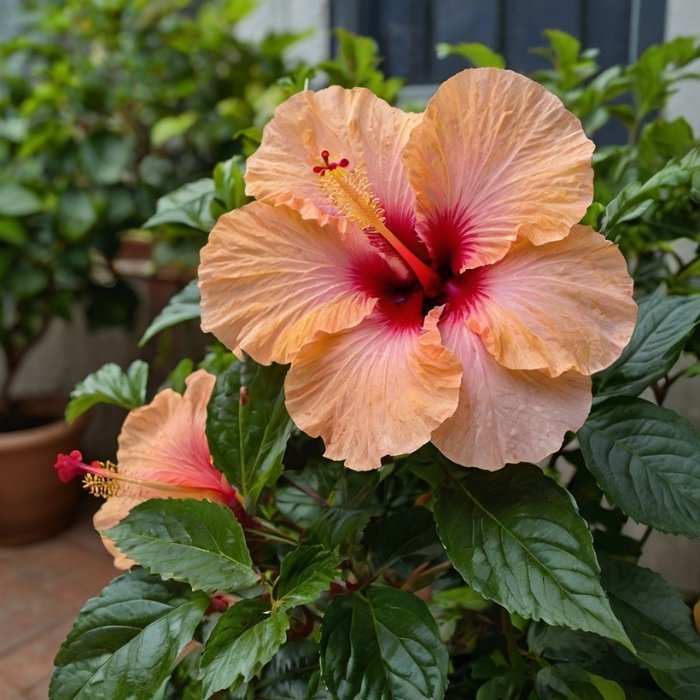Hibiscus Rosa-Sinensis: The Tropical Beauty That Captivates Gardens and Hearts
When it comes to vibrant, eye-catching flowers, few plants can rival the Hibiscus rosa-sinensis. Known for its large, colorful blooms and lush green foliage, this tropical beauty has become a favorite among gardeners, landscapers, and flower enthusiasts worldwide. But there’s more to this plant than meets the eye. In this blog post, we’ll explore everything you need to know about Hibiscus flower—from its origins and symbolism to its care tips and benefits.
What is Hibiscus Rosa-Sinensis?
Hibiscus rosa-sinensis, commonly referred to as Chinese hibiscus or tropical hibiscus, is a flowering plant native to East Asia. It belongs to the Malvaceae family and is widely cultivated for its stunning, trumpet-shaped flowers that come in a variety of colors, including red, pink, orange, yellow, and white.
The name “rosa-sinensis” translates to “rose of China,” reflecting its Asian origins. However, it has become a global symbol of tropical beauty, gracing gardens, patios, and indoor spaces in warm climates around the world.
The Symbolism of Hibiscus Rosa-Sinensis
Beyond its aesthetic appeal, Hibiscus rosa-sinensis holds deep cultural and symbolic significance in many societies:
- Love and Passion: In many cultures, the hibiscus flower symbolizes love, passion, and romance. Its vibrant colors and delicate petals make it a popular choice for weddings and romantic occasions.
- Beauty and Femininity: The flower is often associated with femininity and beauty, making it a common motif in art, fashion, and literature.
- Spiritual Significance: In Hinduism, the hibiscus is offered to the goddess Kali and Lord Ganesha as a symbol of devotion and purity.
Growing Hibiscus Rosa-Sinensis: A Gardener’s Guide
If you’re looking to add a touch of the tropics to your garden, Hibiscus flower is an excellent choice. Here’s how to grow and care for this stunning plant:
1. Climate and Soil Requirements
Hibiscus rosa-sinensis thrives in warm, humid climates and is best suited for USDA hardiness zones 9-11. If you live in a cooler region, you can grow it in pots and bring it indoors during winter.
The plant prefers well-draining, slightly acidic soil with a pH of 6.0-6.5. Adding organic compost or peat moss can improve soil quality and promote healthy growth.
2. Sunlight and Watering
This tropical plant loves full sunlight and requires at least 6 hours of direct sun daily. However, in extremely hot climates, partial shade during the afternoon can prevent leaf scorch.
When it comes to watering, Hibiscus rosa-sinensis prefers consistent moisture. Water the plant deeply 2-3 times a week, ensuring the soil doesn’t become waterlogged. Reduce watering during the winter months.
3. Fertilization and Pruning
To encourage blooming, fertilize your hibiscus with a balanced, water-soluble fertilizer every 2-4 weeks during the growing season. Look for fertilizers with a higher potassium content to promote vibrant flowers.
Pruning is essential to maintain the plant’s shape and encourage new growth. Trim back leggy branches and remove dead or diseased parts in early spring before the growing season begins.
4. Pests and Diseases
While Hibiscus rosa-sinensis is relatively hardy, it can be susceptible to pests like aphids, spider mites, and whiteflies. Regularly inspect the plant and treat infestations with insecticidal soap or neem oil.
Common diseases include leaf spot and root rot, often caused by overwatering or poor drainage. Ensure proper watering practices and avoid wetting the foliage to prevent these issues.
Benefits of Hibiscus Rosa-Sinensis
Beyond its ornamental value, Hibiscus rosa-sinensis offers several benefits:
1. Medicinal Uses
In traditional medicine, hibiscus flowers and leaves have been used to treat various ailments, including:
- High blood pressure: Hibiscus tea, made from the flowers, is known for its ability to lower blood pressure.
- Digestive issues: The plant’s extracts can help soothe stomach discomfort and improve digestion.
- Skin health: Hibiscus is rich in antioxidants and vitamins, making it a popular ingredient in skincare products.
2. Culinary Applications
The flowers of Hibiscus rosa-sinensis are edible and can be used to make teas, jams, and salads. Hibiscus tea, in particular, is a refreshing beverage enjoyed for its tangy flavor and health benefits.
3. Environmental Benefits
Hibiscus plants attract pollinators like bees, butterflies, and hummingbirds, making them a valuable addition to any garden. They also help improve air quality by absorbing carbon dioxide and releasing oxygen.
Fun Facts About Hibiscus Rosa-Sinensis
- The hibiscus flower is the national flower of Malaysia, where it’s known as the “Bunga Raya.”
- In Hawaii, the hibiscus is often worn behind the ear. Wearing it on the right side signifies that you’re single, while wearing it on the left means you’re in a relationship.
- Hibiscus flowers are short-lived, typically lasting only a day or two. However, the plant produces new blooms continuously during the growing season.
Conclusion
Hibiscus rosa-sinensis is more than just a pretty face—it’s a versatile, culturally significant plant that brings beauty, health, and environmental benefits to any space. Whether you’re a seasoned gardener or a beginner, this tropical gem is a rewarding addition to your collection.
By following the care tips outlined in this post, you can enjoy the vibrant blooms of Hibiscus flower year-round. So why wait? Bring home this tropical beauty and transform your garden into a paradise of color and life. Grow Chrysanthemums from Seeds: A Step-by-Step Guide

